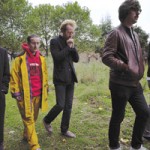Feature
EQ Magazine
March 2010
Link

English band Hot Chip has a particularly kinetic take on dance music. It’s funky machine music with pop soul, a combination cheekily referenced by a recent band shirt boasting an image of R&B eccentric R. Kelly sporting a red Devo hat. The group’s myriad influences came to play on One Life Stand [Astralwerks], a slower, more layered record influenced by the Detroit/Chicago techno/house axis and a 110–120 BPM disco pulse. Between the buoyant, Vangelis-like tones of “Brothers” (created with a detuned Moog Voyager) and “We Have Love,” a funky synth jaunt with a fat rubber bass line, the album is a stylistic free-for-all.
One Life Stand was the first major project recorded in the band’s new East London studio last spring. The space’s straightforward layout was inspired by a visit to Peter Gabriel’s famous Real World complex, where the band recorded a cover of Vampire Weekend’s “Cape Cod Kwassa Kwassa.”
“When you’re putting together a studio, you have to decide if you’re going to try and compete with the big boys or whether you’re going to make it into a place to sketch out ideas,” multi-instrumentalist Al Doyle says.
So the band designed the lone room to be flexible enough to capture fleeting ideas but technically adept to make small, refined adjustments. Reinforcing the band’s improvisational studio style, they connected keyboards and other units to an extensive MIDI setup wired to a Toft ATB24 analog mixing console, which feeds into a computer running Cubase 4. The group also sends a second feed into a computer running Ableton Live for extra tweaking. Meanwhile, a Bricasti M7 Reverb provides spaciousness to sounds recorded in the small room, and the band records vocals with future shaping and editing in mind, via Celemony Melodyne or the Eventide Ultra-Harmonizer, to avoid repetitive extra takes that stifle creativity.
“We want to keep all options open,” Doyle says. “We just really wanted to get a decent signal. We were using these great DI’s made by Radial. We weren’t too concerned about perfecting mics and signal chains. It’s destructive editing at that point. If it’s recorded clean, you can do whatever you want.”
That philosophy guides the band’s use of synths, chosen for their flexibility and utility. A recent acquisition, the Nord Wave, was frequently used for string samples. “Our policy has always been to buy synthesizers that sound good right away,” Doyle says. “It’s liberating.”
On the new album’s title track—a squirrel-y, mid-tempo strut about monogamy—a Doepfer A-100 Modular unit provides a wet, splotchy countermelody after the chorus. Doyle says they prefer the synth’s flexibility and high-end warmth.
“There’s always an issue with filters where you want them to be cutting, but the digital ones can become quite painful on the top end,” he says. “The Doepfer, as well as the Moog Voyager, have a really high filter that’s never too harsh or too present, with really nice mids.”
To add additional texture, Hot Chip took the atypical approach of pairing synths with a steel pan. The metal drum was recorded with a pair of Neumann U 87s on the side and a Beyerdynamic M 260 ribbon mic underneath, capturing multiple dimensions of the ringing minor notes. “The synth lines have the sharp attack and the steel pan provides sustain,” Doyle says.
Along with the use of an upright Steinway piano on the country-esque track “Slush”—miked with three Shure pencil condenser mics to capture the natural resonation of the instrument and contrasted with Alexis Taylor’s cutting voice, recorded on a Shure SM7B— Hot Chip layered multiple acoustic and synthetic melodies.
But, being a dance band, much of the focus still sits with rhythm and bass. Guest drummer Charles Haywood, who has played with This Heat, played a snare set up with top and bottom Neumann KM 184 mics. During mixing, producer Dan Carey sent the signal through a Manley SLAM! limiter.
“The whole track will have mastering compression, and we also used the iZotope Alloy program,” Doyle says. “It has a great multi-band harmonic exciter that’s very usable. It’s also very subtle. When we were learning our craft, we went towards gear that had really wild effects. As we’ve done a lot more mixing and dealing with tracks that have hundreds of stems to them, we realize you can do something subtle on each track.
“Coming from a dance music background, we want our tracks to really stand up on the dancefloor—tracks that aren’t in that German techno vein, but take that propulsion and transfer it to a different realm.”